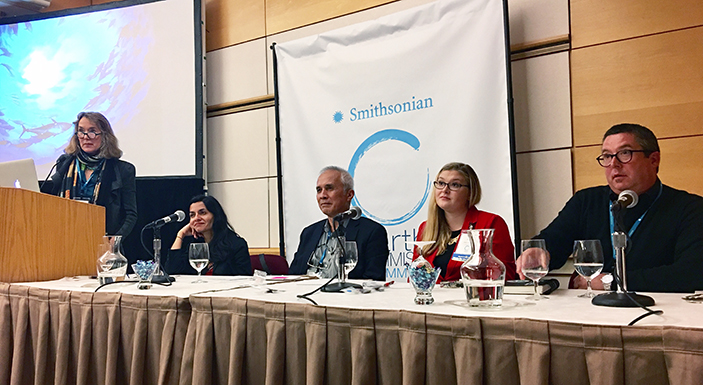BRIDGE Supports Food Security Panel at 2017 Earth Optimism Summit
May 08, 2017
What do chocolate, forests, sea turtles, and fisheries management have in common? The answer lies with biodiversity conservation for food security. These were topics recently discussed by four speakers who emphasized the importance of biodiversity conservation across development sectors.
The panel discussion took place during the Smithsonian Institution’s Earth Optimism Summit in Washington, D.C., during a session called “The Wild Table.” The discussion was supported by the U.S. Agency for International Development (USAID)’s Biodiversity Results and Integrated Development Gains Enhanced (BRIDGE) Project, implemented by DAI. This presentation showcased BRIDGE’s work with the Agency’s Office of Forestry and Biodiversity to integrate biodiversity conservation into development initiatives, such as food security.

The Wild Table presenters share insights into how biodiversity conservation improves the quality and availability of food. From left, are: Leslie Cockburn (moderator), Simran Sethi, Nygiel Armada, Kelsey Evezich, and Terry Sunderland. Photo by Karen Louise Boothe.
Simran Sethi, journalist, author, and educator, began the discussion with a look at one of her favorite foods, chocolate. During research for her book, “Bread, Wine, Chocolate: The Slow Loss of Foods We Love,” Sethi learned that all foods reflect the taste of place that makes enjoying food a full sensory experience. “That reflection of taste of place is a reflection of the biodiversity in areas where food is grown.”
Terry Sunderland, principal scientist at the Center for International Forestry Research (CIFOR), focused on the interactions between forests and the people and animals that depend on them. To better understand this connection, he and his team from CIFOR turned to USAID’s Demographic and Health Surveys Program’s data to compare dietary diversity under different levels of tree cover.
“We found a very positive correlation between tree cover and diets. The closer people are to forests and tree formations, the better their diets. This is pretty powerful stuff,” Sunderland says.
Kelsey Evezich, an undergraduate student at Duke University in North Carolina, presented a research project undertaken by Duke’s Conservation Technology Club which took on the task of creating a less expensive light-emitting diode (LED) that can be attached to gill fishing nets to prevent the inadvertent bycatch of sea turtles. “The takeaway message of this activity is not just the creation of this device, but the success of interdisciplinary collaboration and conversations,” she says. “This type of cross-pollination of ideas is the key to future success and conservation.”
Nygiel Armada, Chief of Party for the USAID-funded Philippines-based ECOFISH Project, continued the theme of how fisheries management can improve both food security and biodiversity. He gave several examples of using evidence to encourage communities and programs to increase sustainability. The bottom line, says Armada, is to use science to inform partners and to move the project in the right direction.
The presenters agreed that through continuing the conversation across development sectors and disciplines, biodiversity conservation solutions will be found. Visit the Earth Optimism Summit website to learn more or search #EarthOptimism on social media.
RELATED CONTENT:
Haiti President Visits USAID AVANSE Booth at Agriculture Fair
In honor of Agriculture and Labor Day, the President of the Republic of Haiti, Jovenel Moïse, recently visited AVANSE exhibition at the Agricultural Fair held in northeast Haiti.
Read More